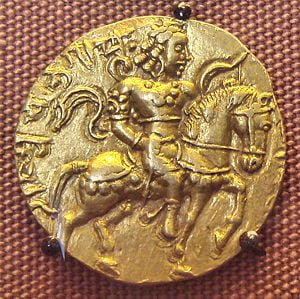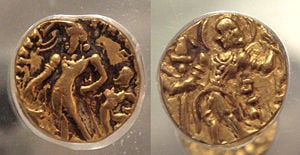Difference between revisions of "Chandragupta II" - New World Encyclopedia
Dan Davies (talk | contribs) |
Dan Davies (talk | contribs) (external links) |
||
| Line 96: | Line 96: | ||
* Majumdar, R. C. 1964. Ancient India. Delhi: Motilal Banarsidass. OCLC 1075813. | * Majumdar, R. C. 1964. Ancient India. Delhi: Motilal Banarsidass. OCLC 1075813. | ||
* Kulke, Hermann, and Dietmar Rothermund. 1998. A history of India. London: Routledge. ISBN 9780415154819. | * Kulke, Hermann, and Dietmar Rothermund. 1998. A history of India. London: Routledge. ISBN 9780415154819. | ||
| + | |||
| + | ==External Sites== | ||
| + | * [http://www.hyperhistory.com/online_n2/people_n2/ppersons3_n2/chandragupta.html HyperHistory Chandra Gupta II, c.350 - c.415, King of India]. Retrieved June 9, 2008. | ||
| + | * [http://www.datesofhistory.com/Chandragupta-II-India.biog.html World History Database, History of India, Chandragupta II]. Retrieved June 9, 2008. | ||
| + | * [http://www.fsmitha.com/h1/ch28gup.htm The Gupta Empire and Hinduism, A Greater Golden Age]. Retrieved June 9, 2008. | ||
| + | |||
| + | |||
{{s-start}} | {{s-start}} | ||
Revision as of 22:50, 9 June 2008
| Chandragupta hi II Vikramaditya | ||
|---|---|---|
| Gupta emperor | ||

| ||
| Coin of Chandragupta II. British Museum. | ||
| Reign | 375 - 415 C.E. | |
Chandragupta II (very often referred to as Vikramaditya or Chandragupta Vikramaditya) was one of the most powerful emperors of the Gupta empire. His rule spanned 375-413/15 C.E., during which the Gupta empire achieved its zenith. The period of prominence of the Gupta dynasty is very often referred to as the Golden Age of India. Chandragupta was the son of the previous ruler, Samudragupta. He attained success by pursuing both a favorable marital alliance and an aggressive expansionist policy. In this his father and grandfather set the precedent.
Biography
Not much is known about the personal details of the great king. His mother, Datta Devi, was the chief queen of Samudragupta. The most widely accepted details have been built upon the plot of the play 'Devi-Chandraguptam' of Vishakadatta. The play is now lost but fragments have been preserved in other works (Abhinava-bharati, Sringara-prakasha, Natya-darpana, Nataka-lakshana Ratna-kosha). There even exists an Arabic work Mujmalu-t-Tawarikh which tells a similar tale of a king whose name appears to be a corruption of 'Vikramaditya'.
The fragment from Natya-darpana mentions the king Ramagupta, the elder brother of Chandragupta, surrendering his queen Dhruvaswamini to the Saka king of the Western Kshatrapas Rudrasimha III, after a defeat at the Saka king's hands. To avoid the ignominy the Guptas decide to send Madhavasena, a courtesan and a beloved of Chandragupta, disguised as the queen. However, Chandragupta changes the plan and himself goes to the Saka King disguised as the queen. He then kills Rudrasimha and later his own brother, Ramagupta. Dhruvaswamini is then married to Chandragupta.
We do not know what liberties Vishakadatta took with the incidents, but Dhruvadevi was indeed the king's chief queen as seen in the Vaisali terracotta seal that calls her ‘Mahadevi’ Dhruvasvamini. The Bilsad pillar inscription of their son Kumara Gupta I also refers to her as Mahadevi Dhruvadevi. A Ramagupta too is mentioned in inscriptions on Jain figures in the District Archaeological Museum, Vidisha and some copper coins found at Vidisha. The fact that the king and Dhruvadevi are the protagonists of Vishakadatta's play indicates that marrying his widowed sister-in-law was not given any significance by the playwright. However, later Hindus did not view such a marriage with favour and some censure of the act is found in the Sanjan copperplate inscription of Amoghavarsha I and in the Sangali and Cambay plates of the Rashtrakuta king Govinda IV.
The Allahabad pillar inscription mentions the marriage of Chandragupta with a Naga princess Kuberanaga. A pillar from Mathura referring to Chandragupta (Candragupta) has recently been dated to 388 C.E.[2]
Chandragupta's daughter Prabhavati by his other queen Kuberanaga, a Naga princess, was married to the powerful Vakataka king Rudrasena II.
The Empire
His greatest victory was his victory over the Shaka-Kshatrapa dynasty and annexation of their kingdom in Gujarat, by defeating their last ruler Rudrasimha III.
His son-in-law Rudrasena II died fortuitously after a very short reign in 390 C.E., following which Prabhavatigupta ruled as a regent on behalf of her two sons. During this twenty year period the Vakataka realm was practically a part of the Gupta empire. The geographical location of the Vakataka kingdom allowed Chandragupta to take the opportunity to defeat the Western Kshatrapas once for all. Many historians refer to this period as the Vakataka-Gupta age.
Chandragupta II controlled a vast empire, from the mouth of the Ganges to the mouth of the Indus River and from what is now North Pakistan down to the mouth of the Narmada. Pataliputra continued to be the capital of his huge empire but Ujjain too became a sort of second capital. The large number of beautiful gold coins issued by the Gupta dynasty are a testament to the imperial grandeur of that age. Chandragupta II also started producing silver coins in the Shaka tradition.
His Reign
Faxian (Fa-shien) was the first of three great Chinese pilgrims who visited India from the fifth to the seventh centuries AD, in search of knowledge, manuscripts and relics. He arrived during the reign of Chandragupta II and gave a general description of North India at that time. Among the other things, he reported about the absence of capital punishment, the lack of a poll-tax and land tax and the presence of a strongly embedded caste system. Most citizens did not consume onions, garlic, meat and wine. The exception to this were the Chandalas, who were shunned in society and segregated from other people.
Culturally too, the reign of Chandragupta II marked a Golden Age. This is evidenced by later reports of the presence of a circle of poets known as the Nine_Gems in his court. The greatest among them was Kalidasa, who authored numerous immortal pieces of literature including The Recognition of Shakuntala, and he is often referred to as the Shakespeare of India. One other was Varahamihira who was a famous astronomer and mathematician.
The next day after the Hindu festival Diwali is called Padwa or Varshapratipada, which marks the coronation of King Vikramaditya. The Hindu Shaka-Samvat calendar was apparently started on this day and this day is celebrated as new year's day in some places (which is confusing because the Vikram-Samvat is synchronised with the Vikram-Samvat calendar, which starts around April, in some parts of India).
The famous iron pillar
Close to the Qutub Minar is one of Delhi's most curious structures, an iron pillar, dating back to 4th century CE. The pillar bears an inscription which states that it was erected as a flagstaff in honour of the Hindu god Vishnu, and in the memory of Chandragupta II. The pillar also highlights ancient India's achievements in metallurgy. The pillar is made of 98% wrought iron and has stood more than 1,600 years without rusting or decomposing. This iron pillar is similar to the Pillars of Ashoka found mostly in northern India. From Chandragupta II kings were known as Parama Bhagavatas, or Bhagavata Vaishnavas. The Bhagavata Purana entails the fully developed tenets and philosophy of the Bhagavata cult whereis Krishna gets fused with Vasudeva and transcendds Vedic Vishnu and cosmic Hari to be turned into the ultimate object of bhakti.[3]
Campaigns against foreign tribes
- Fourth century AD Sanskrit poet Kalidasa, credits Chandragupta Vikramaditya (aka Raghu) with having conquered about twenty one kingdoms, both in and outside India. After finishing his campaign in the East, South and West India, Raghu aka Vikramaditya (Chandragupta II) proceeded northwards, subjugated the Parasikas (Persians), then the Hunas and the Kambojas tribes located in the west and east Oxus valleys respectively. Thereafter, the glorious king proceeds across the Himalaya and reduced the Kinnaras, Kiratas etc and lands into India proper [4].
- According to the Brihat-Katha-Manjari of the Kashmiri Pandit Kshmendra, king Vikramaditya (Chandragupta II) had "unburdened the sacred earth of the Barbarians like the Shakas, Mlecchas, Kambojas, Yavanas, Tusharas, Parasikas, Hunas, etc. by annihilating these sinful Mlecchas completely" [5] [6] [7].
See also
- Vikramaditya
Notes
- ↑ "Evidence of the conquest of Saurastra during the reign of Chandragupta II is to be seen in his rare silver coins which are more directly imitated from those of the Western Satraps... they retain some traces of the old inscriptions in Greek characters, while on the reverse, they substitute the Gupta type (a peacock) for the chaitya with crescent and star." in Rapson "A catalogue of Indian coins in the British Museum. The Andhras etc...," p.cli
- ↑ Falk, Harry. (2004) "The Kaniṣka era in Gupta Records." Silk Road Art and Archaeology 10. Kamakura: The Institute of Silk Road Studies, pp. 167-176.
- ↑ Kalyan Kumar Ganguli: (1988). Sraddh njali, Studies in Ancient Indian History: D.C. Sircar Commemoration: Puranic tradition of Krishna. Sundeep Prakashan. ISBN 8185067104. p.36
- ↑ (Raghu Vamsa v 4.60-75.
- ↑
- ata shrivikramadityo helya nirjitakhilah|:
- Mlechchana Kambojan Yavanan Neecan Hunan Sabarbran||
- Tushara Parsikaanshcha tayakatacharan vishrankhalan|
- hatya bhrubhangamatreyanah bhuvo bharamavarayate||
- (Brahata Katha, 10/1/285-86, Kshmendra).
- ↑ Kathasritsagara 18.1.76-78.
- ↑ Cf:"In the story contained in Kathasarit-sagara, king Vikarmaditya is said to have destroyed all the barbarous tribes such as the Kambojas, Yavanas, Hunas, Tokharas and the Persians "(See: Ref: Reappraising the Gupta History, 1992, p 169, B. C. Chhabra, Sri Ram; Cf also: Vikrama Volume, 1948, p xxv, Vikramāditya Śakāri; cf: Anatomii͡a i fiziologii͡a selʹskokhozi͡a ĭstvennykh zhivotnykh, 1946, p 264, Arthur John Arberry, Louis Renou, B. K. Hindse, A. V. Leontovich, National Council of Teachers of English Committee on Recreational Reading - Sanskrit language.
ReferencesISBN links support NWE through referral fees
- Mukerji, Radha Kumud. 1973. The Gupta empire. Delhi: Motilal Banarsidass. OCLC 59795845.
- Majumdar, R. C. 1964. Ancient India. Delhi: Motilal Banarsidass. OCLC 1075813.
- Kulke, Hermann, and Dietmar Rothermund. 1998. A history of India. London: Routledge. ISBN 9780415154819.
External Sites
- HyperHistory Chandra Gupta II, c.350 - c.415, King of India. Retrieved June 9, 2008.
- World History Database, History of India, Chandragupta II. Retrieved June 9, 2008.
- The Gupta Empire and Hinduism, A Greater Golden Age. Retrieved June 9, 2008.
Credits
New World Encyclopedia writers and editors rewrote and completed the Wikipedia article in accordance with New World Encyclopedia standards. This article abides by terms of the Creative Commons CC-by-sa 3.0 License (CC-by-sa), which may be used and disseminated with proper attribution. Credit is due under the terms of this license that can reference both the New World Encyclopedia contributors and the selfless volunteer contributors of the Wikimedia Foundation. To cite this article click here for a list of acceptable citing formats.The history of earlier contributions by wikipedians is accessible to researchers here:
The history of this article since it was imported to New World Encyclopedia:
Note: Some restrictions may apply to use of individual images which are separately licensed.
|
| ||
|---|---|---|
| Preceded by: Samudragupta |
Gupta Emperor 375 – 414 |
Succeeded by: Kumara Gupta I |

